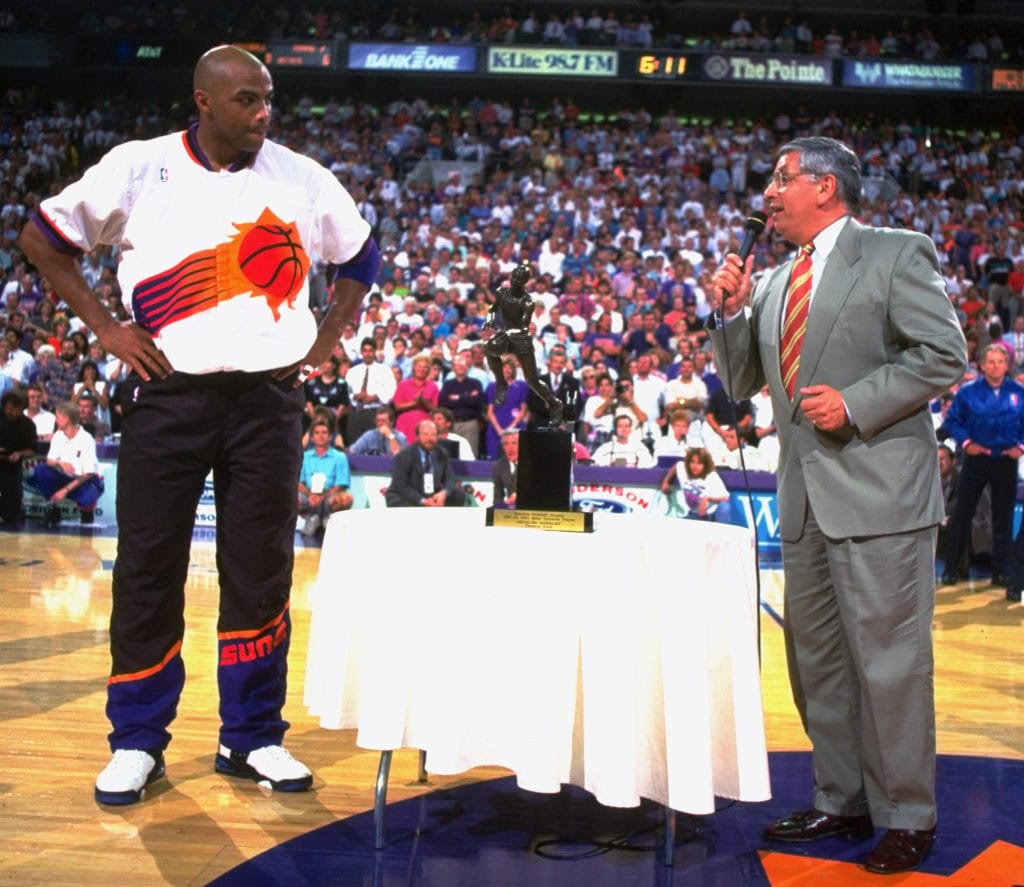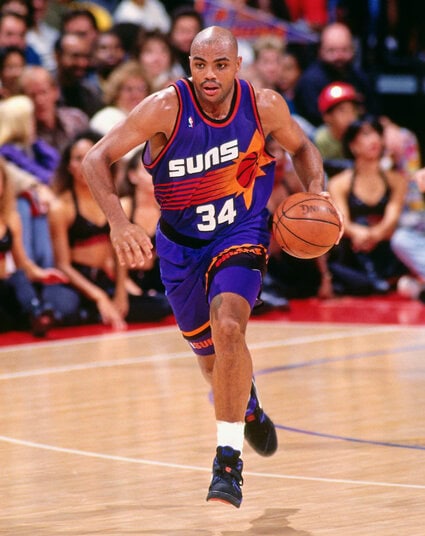To celebrate the 30th anniversary of their trip to the 1993 NBA Finals, the Suns will don their most iconic jersey throughout the 2022-23 season.
Throughout the course of the league’s 75 seasons to date, each and every fanbase has that one uniform that is held above all other looks. In Phoenix, a sublimated graphic Suns throwback jersey featuring a streaking, shining basketball from the 1990s is undoubtedly that.
And for the first time in over 20 years, the Suns announced plans Tuesday to bring the purple “Sunburst” jersey back, slotting the design in as its Nike Classic Edition to be worn throughout the upcoming season.
Debuting at the start of the 1992-93 season, the uniform was headlined by newcomer Charles Barkley, who went on to win league MVP in the jerseys as the Suns raced to just their second-ever NBA Finals appearance.
To hear all about the starting points of the original Sunburst jersey, the impact it had throughout the 90s, and the excitement now around its return, Boardroom caught up with three of the franchise’s key stakeholders from then to now.
The Original Design
Since the Suns franchise was founded in 1968, the team relied on a simple purple and orange color scheme that pulled from hues from The Valley’s iconic sunsets.
By the turn of the 1990s, the team’s new ownership led by Jerry Colangelo was looking to overhaul the Suns’ identity and branding. They called upon the NBA league office in New York for design help, with Tom O’Grady, the NBA’s first creative director, leading the sketching process in tandem with the Suns.

Let’s set the scene.
Tom Ambrose, former Phoenix Suns VP of Marketing: We were moving out of the old [Arizona Veterans Memorial] Coliseum and moving into the new downtown arena, so that was the real impetus for the uniform change. Jerry Colangelo really wanted to see a new, clean, modern look.
Jerry Colangelo, in 1992: We feel it’s the ideal time to change our logo and uniforms with the opening of the new arena. It was the closing of the first chapter in Suns history, after a quarter century as well. I want to create something modern and bold to reflect the nature of the new arena and the growth of Phoenix. And I don’t want to revisit a new logo and uniforms soon.
Mark West, Suns starting center: It was impressive, just to have something new. It was really the anticipation for the new year. We had the new uniforms coming out, Charles was [new] to the team, we had planned for a new arena from the old Veteran’s Coliseum, and there was just crazy excitement for everyone involved. … We also had a new coach in Paul Westphal. Everything was new going into that season.
Ambrose: Our old uniforms had a western-style typeface and a Sunburst, but it was on the side of the shorts. He wanted a change. He wanted to see some ideas. … It kind of fell to me to put that together. I always consulted with Colangelo, but also Dick Van Arsdale, who was the original Sun.
Graham Wincott, Suns Senior Director of Marketing: They hadn’t really overhauled the uniforms in the team’s 25-year history to that point. Really, just the font had changed from the original ’68 font to the western font in ’73. Bringing the Suns into that 90s era, they were very 90s uniforms. If you look back, everyone had cartoony uniforms and this was probably one of the most iconic of that time period.


Ambrose: We looked at a lot of different things. I even looked at maybe changing the colors even, from purple and orange to maybe silver and dark blue. We explored a lot of different possibilities … That got shot down pretty quickly [laughs].
West: The style had changed. With the Jordan era, there were longer shorts and more vibrant jerseys. That all added to the aura of the year and the jerseys.
Ambrose: The NBA had a design department that we worked with very closely, and they came up with all kinds of ideas. One of them was sort of a goth style, which didn’t fly. We decided that we should somehow keep the Sunburst on the uniform somewhere. … Our little committee kept looking at it, and we kept the NBA’s design department busy for a while. That one, everyone nodded ‘Yes’ and that was it.
West: I always thought the Bulls had a nice uniform, and now we had something that could compete in that area. If someone saw our jerseys, they wanted those now, too. The old-style jerseys, they weren’t even close.

The Breakthrough 1992-93 Season
The start of the Suns’ league-best 62-20 campaign in 1992-93 came at home against the Clippers, with Barkley making his Phoenix debut with a monster 37-point, 21-rebound, eight-assist outing on just 16 shots from the field. West recalls hearing that fans were leaving their seats during the middle of the game to see if the new jerseys were already on sale at the arena’s team store.
While the Suns eventually lost the 1993 NBA Finals in six games to Michael Jordan’s Chicago Bulls, players and team execs alike recall the frenzy and energy taking the franchise to new heights around town.
Downtown buildings left office lights on at night to spell out “Suns” across several floors. A parade was held through downtown Phoenix – after the Finals loss – that drew more than 300,000 fans. The impact of that season in the new Sunburst unis had brought the franchise a new nationwide fanbase for the first time.
West: Going into the new arena and bringing Charles in, the expectation, at least in my mind, was that we were going to win it all … The whole thing was, if we get Charles Barkley here, that’ll be the piece to get us to the Finals. Obviously, that’s the way it turned out.

Wincott: The Finals appearance was a really big watershed moment for us. Going back to 1992-93, it was the first season after the Barcelona Olympics with the Dream Team, and the NBA was put on the global map. The Suns had four straight 50-win seasons.
Going into that year, the Suns had just gotten Charles Barkley, and that really put them over the edge, [finishing] with the best record in the league and he won MVP. It told a lot of the world who the Suns were, where Phoenix is, and it made us a household name as basketball was really taking off.

West: We didn’t have the [big campaigns back then], even for other teams that brought out new uniforms.
Wincott: It never had even a formal launch at all. The team basically walked out in them on opening night. They didn’t even arrive until the day of the game. They didn’t have the numbers right, and had to have them fixed by a seamstress on the day of the game. And then they just walked out in them.
West: We were just happy to have something that was going to be different and looked pretty cool.
Ambrose: It was like it was good karma that everything looked right.
West: The design was ridiculously vibrant and fresh for the times. You can’t separate the two — that we were also playing well, winning games, and we were an exciting team to watch. With all of that, when you had that jersey on, you represented a team that was doing those things.
Tom O’Grady, NBA Creative Director: My fear was that the Suns graphic would not have a common “sweet spot” on all these different sized and shaped players. Alas, it was not an issue, and once I saw Charles Barkley in the new uniforms, I was struck on how cool they were and how the designs fundamentally broke new branding ground for teams.

Bringing Back the Sunburst
As the league looks ahead to its annual anniversary calendar, it prioritizes select teams each season for modernized remakes dubbed “Classic Edition.” Typically, teams are asked to celebrate anniversaries in five or 10-year increments, setting the stage for the Suns to honor and highlight one of the greatest teams in franchise history from three decades ago.
Wincott: It’s a year-by-year approach, but we want to make sure that there’s purpose and a story behind everything that we do. There has to be a meaning and a follow-through. We’re not just going to throw out a jersey and wear it; there has to be a story.
As we were going into the planning of the last six and seven seasons, the parallels of having a team on the rise and an All-Star coming to put them over the edge with a Finals trip – there was just too much synergy there.

We had Dan [Majerle] and Charles back for the [2021 NBA Finals] campaign, and we were just starting in on this and it made too much sense.
With it being the 30th anniversary and being able to celebrate a team that established itself during the ‘90s as a team that didn’t miss the playoffs during that decade in these uniforms during that entire era, I couldn’t think of a better thing to celebrate.
[The new design] is sublimated, and there was a lot of re-working to have [the design] anchored at the armpit for different sizes. The jerseys are a lot more form-fitting, and that was one of the more significant concerns going into it.
How do you create the font and Sunburst and still have it not bring down the whole weight of the jersey? It was one of the more challenging ones that Nike has done in modernizing [the design] for the new silhouette, but they did a tremendous job. It’s pretty much a direct copy of the design.

Excitement Ahead
Throughout the 1992-93 regular season and playoffs, the Suns broke out the purple Sunburst jersey for a total of 52 times. That’s because they only had two options: the traditional white uniform for home games and the purple jersey on the road.
With as many as five jersey “Editions” to choose from this season, the team says they might wear their new Sunburst unis as many as 20 times. Teams select the jersey of their choosing for home games no matter the base color, with the road team then making a contrasting choice; the opportunities will be there.

Wincott: The minimum is four [games worn], but we’re going to go way beyond that. As it stands now, we’re going to wear them for at least a quarter of our home games. Once we see what our road opponents have selected, then we’ll definitely slot it in for some road games too. We’ll have a fully immersive theme night series that goes along with it.
West: To me – and I have a bias, no question – they’re the best-looking jerseys the Suns have had.
Wincott: Every poll that I’ve ever put out, the purple version of this Sunburst jersey is the No. 1 most popular one in team history. Historically, this one and the white are one and two. The black version comes in at three. Then, everything else is distant from there.
Ambrose: It still works. It’s not like we’re going back to six-inch letters and no names on the back of the jerseys.
West: For them to wear that jersey and to represent our team, when they’ve set their own [mark], have been to the Finals, set the most [franchise] wins in a season, and have done so much, it’s remarkable. They’ve gotten to where we’ve gotten, with hopes of doing better.
Wincott: The easiest [thing] in this uniform and branding space is when you know fans want something and you’re just giving them what they want.